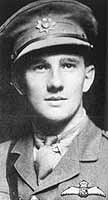Robert L. Chidlaw-Roberts facts for kids
Quick facts for kids
Robert Leslie Chidlaw-Roberts
|
|
|---|---|
 |
|
| Born | 9 May 1896 Tywyn, Merionethshire, Wales |
| Died | 16 January 1989 (aged 92) Winchester, Hampshire, England |
| Allegiance | United Kingdom |
| Service/ |
British Army Royal Air Force |
| Years of service | 1915–1920 1942–1954 |
| Rank | Flight Lieutenant |
| Unit | Hampshire Regiment No. 2 Squadron RFC No. 18 Squadron RFC No. 40 Squadron RFC No. 60 Squadron RFC/RAF |
| Battles/wars | First World War Second World War |
| Awards | Military Cross Air Force Cross |
Flight Lieutenant Robert Leslie Chidlaw-Roberts (born May 9, 1896 – died June 1, 1989) was a brave British pilot. He was known as a "flying ace" during First World War. This means he shot down ten enemy aircraft in air battles.
He was part of some very famous air fights. He helped to shoot down a well-known German ace named Werner Voss. Later, in January 1918, he also shot down another top German pilot, Max Ritter von Müller. Robert Chidlaw-Roberts also served in the Royal Air Force during and after Second World War.
Contents
Life Story
Early Years
Robert Leslie Chidlaw-Roberts was born in Tywyn, a town in Wales, in May 1896.
World War I Adventures
Robert went to a special military school called Royal Military College, Sandhurst. He became an officer in the Hampshire Regiment in June 1915. Soon after, he joined the Royal Flying Corps, which was the air force before the Royal Air Force was created.
- First Job in the Air: For six months, he worked as an observer and gunner in the air with No. 2 Squadron RFC. This meant he helped spot things from the sky and fired guns.
- Becoming a Pilot: He then learned to fly planes himself. He earned his pilot's license in January 1916. By April 1916, he was officially a flying officer.
- Flying with No. 18 Squadron: From May to December 1916, Robert flew Royal Aircraft Factory FE.2b planes with No. 18 Squadron RFC. During this time, he was promoted to lieutenant.
- Joining No. 60 Squadron: In August 1917, he moved to No. 60 Squadron RFC. This is where he took part in some very important air battles.
- Fighting Werner Voss: He was one of the British pilots who fought against Werner Voss. Voss was a very skilled German pilot, and this was his last fight on September 23, 1917.
- Shooting Down Max Ritter von Müller: On January 9, 1918, Robert shot down and killed another famous German ace, Max Ritter von Müller. This German pilot had won 36 air battles.
- Rest and Training: After these intense battles, Robert was sent back to England for a rest. He worked at a training squadron, helping new pilots.
- Military Cross Award: For his amazing bravery and skill, Robert was given the Military Cross medal on February 1, 1918.
- Return to the Front: In the summer of 1918, he went back to the front lines. He became a flight commander, leading a group of planes in No. 40 Squadron RAF.
Between the Big Wars
After World War I, Robert was one of the RAF pilots who served in Russia in 1919. In 1920, he left the Royal Air Force for a short time. He went back to the Hampshire Regiment as a lieutenant. But soon after, he left the army and joined a special reserve group.
World War II Service
Robert Chidlaw-Roberts returned to active duty on May 12, 1942. He joined the Royal Air Force Volunteer Reserve as a pilot officer. On September 1, 1944, he was awarded the Air Force Cross for his service.
He stayed in the RAF even after World War II ended. He officially retired from the Royal Air Force on February 10, 1954.
Awards and Recognition
Robert Leslie Chidlaw-Roberts received two important medals for his service:
- Military Cross: This medal was given to him for being extremely brave and dedicated. He often attacked enemy planes even when they were outnumbered. Once, he bravely attacked five enemy planes by himself, flying right into them and attacking each one up close. He also shot down three other enemy planes on different occasions. He was known for his great skill and courage.
- Air Force Cross: This medal is given for acts of exemplary gallantry while flying, but not in active combat against the enemy.

